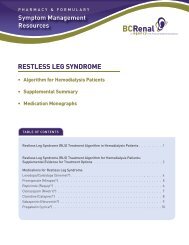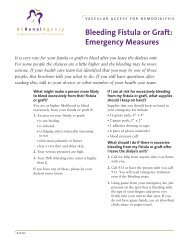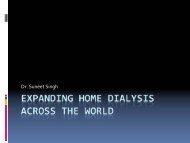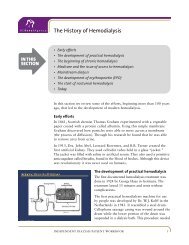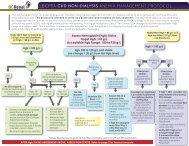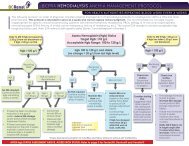St. Paul's Hospital Peritoneal Dialysis Catheter ... - BC Renal Agency
St. Paul's Hospital Peritoneal Dialysis Catheter ... - BC Renal Agency
St. Paul's Hospital Peritoneal Dialysis Catheter ... - BC Renal Agency
You also want an ePaper? Increase the reach of your titles
YUMPU automatically turns print PDFs into web optimized ePapers that Google loves.
<strong>St</strong>. Paul’s <strong>Hospital</strong><strong>Peritoneal</strong> <strong>Dialysis</strong> <strong>Catheter</strong>Bedside InsertionG. Nussbaumer
SPH – Bedside PD <strong>Catheter</strong>s• Thanks to Dr. Abeed Jamal• Data obtained from PROMIS AccessModule
SPH – Bedside PD <strong>Catheter</strong>s• Pt. Selection• Technique Used• Patient Numbers• Advantages/Disadvantages• Outcomes
SPH – Bedside PD <strong>Catheter</strong>s• Pt. Selection• Technique Used• Patient Numbers• Advantages/Disadvantages• Outcomes
SPH – Bedside PD <strong>Catheter</strong>s• Almost everyone is a candidate for bedsideinsertion• Exceptions– Pt. Needing other surgical intervention such ashernia repair– Pt. With previous hernia repair with mesh (thatis in the way)– Pt. With multiple previous abdominal surgeries
SPH – Bedside PD <strong>Catheter</strong>s• Admit over night• Procedure takes 30 to 45 minutes
SPH – Bedside PD <strong>Catheter</strong>s• Technique Used• Patient Numbers• Advantages/Disadvantages• Outcomes
SPH – Bedside PD <strong>Catheter</strong>s• Peritoneoscope• Procedure Room on <strong>Renal</strong> Ward
SPH – Bedside PD <strong>Catheter</strong>s
SPH – Bedside PD <strong>Catheter</strong>s
SPH – Bedside PD <strong>Catheter</strong>s• 1 % xylocaine with epinephrine• 1 cm incision approx. 2 cm below umbilicus• Quill inserted into peritoneum, abdomeninsufflated with 1 liter air• Quill directed to LLQ with peritoneoscope• Scope removed, quill dilated• PD cath advanced through quill as quill isremoved
SPH – Bedside PD <strong>Catheter</strong>s
SPH – Bedside PD <strong>Catheter</strong>s• PD catheter connected to flush• If good inflow and outflow, tunnel ismeasured and frozen• PD tube pulled through tunnel, fitted withtitanium adapter, transfer set, capped ofwith 7cc 1000 u/ml heparin• Midline incision sutured with 2 2-0 silksutures
SPH – Bedside PD <strong>Catheter</strong>s
SPH – Bedside PD <strong>Catheter</strong>s• Technique Used• Patient Numbers• Advantages/Disadvantages• Outcomes
SPH – Bedside PD <strong>Catheter</strong>sPt. #Bedside Surgical Total # Pts2005-Aug41(85%)2006 50(89%)2007 72(95%)2008 29(94%)7 48 462,26 56 524,24 76 711,3 3,22 31 27 4,2
SPH – Bedside PD <strong>Catheter</strong>s• Technique Used• Patient Numbers• Advantages/Disadvantages• Outcomes
SPH – Bedside PD <strong>Catheter</strong>sAdvantages• No wait for PD tube insertions• No mistakes with insertion/tube assembly• Smaller incision, faster recovery, lessbleeding• Significantly less cost to healthcare system• Easier to initiate changes toprocedure/equipment etc.
SPH – Bedside PD <strong>Catheter</strong>sDisadvantages• Visualization not as good as in OR• No lysis of adhesions etc.• Loss of surgical expertise• Pt. awake• Pt. discomfort from intraperitoneal air
SPH – Bedside PD <strong>Catheter</strong>s• Technique Used• Patient Numbers• Advantages/Disadvantages• Outcomes
SPH – Bedside PD <strong>Catheter</strong>Outcomes• Inability to place PD catheter (6/217 =2.8%)• Perforation of Viscus (1/212 = 0.47%)• Early infection (< 30 days post insert 0%)• Nonfunctioning catheter (14/211 6.6%)
SPH – Bedside PD <strong>Catheter</strong>Outcomes• Various reports of catheter obstruction 5 – 35 %• Usually secondary to wrapping of omentum– Tenckhoff recommended a caudally placed intraperitonealcatheter segment so the tip enters the pelvis because theomentum does not extend into the pelvis– Skin exit site also needs to be directed down– Cuff acts as a fulcrum and catheter memory causescephalad displacement of catheter
SPH – Bedside PD <strong>Catheter</strong>Outcomes• Factors implicated in Obstruction– Adhesions– Body Habitus– Omentum– <strong>Catheter</strong> migration
SPH – Bedside PD <strong>Catheter</strong><strong>Catheter</strong> Migration• Reversible versus Permanent– Left side• Thought to be reversible, due to peristalsis ofdescending colon– Right side• Peristalsis of ascending colon displaces the catheterfurther cephalad
SPH – Bedside PD <strong>Catheter</strong><strong>Catheter</strong> Migration
SPH – Bedside PD <strong>Catheter</strong><strong>Catheter</strong> Migration• Prevention– <strong>Catheter</strong> Design• Multiple different designs– Cuffs– Coiled versus straight– Weighted– Swan neck versus straight
SPH – Bedside PD <strong>Catheter</strong><strong>Catheter</strong> Migration• How to avoid?– <strong>Catheter</strong> design
SPH – Bedside PD <strong>Catheter</strong>sMigration Prevention• Gadallah et al, 2000 Adv in PD– Six Year study comparing straight versus swanneck catheters in 2 centers• Only examined laparscopically placed catheters• All catheters were coiled and identical other than theswan neck
SPH – Bedside PD <strong>Catheter</strong>sMigration Prevention• Swan Neck– N= 243– Age 49– 58 % Caucasian– 82% Diabetic– Body weight 81.2kg– Prior Abd Surgery46%• <strong>St</strong>raight– N= 219– Age 46– 66% Caucasian– 74 % Diabetic– Body weight 77.5kg– Prior Abd Surgery48%
SPH – Bedside PD <strong>Catheter</strong>sMigration Prevention• Non functioning catheters– Documented x-ray evidence of migration– 48 hour trial of laxatives• Soap suds enema• PO Sorbitol• If patency restored these patients were not countedas migration, but if still non-functioning aftercatharsis, then included
SPH – Bedside PD <strong>Catheter</strong>sMigration Prevention• Results– Migration rates• 2/243 Swan neck =
SPH – Bedside PD <strong>Catheter</strong>sPt. #Bedside Surgical Total # Pts2005-Aug41(85%)2006 50(89%)2007 72(95%)2008 29(94%)7 48 462,26 56 524,24 76 711,3 3,22 31 27 4,2
SPH – Bedside PD <strong>Catheter</strong>sSummary• Bedside PD catheter insertions aresuccessful• Result in more timely intervention• Low complication Rates




